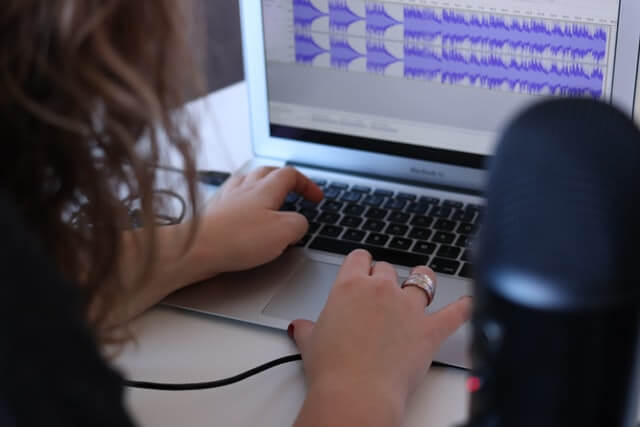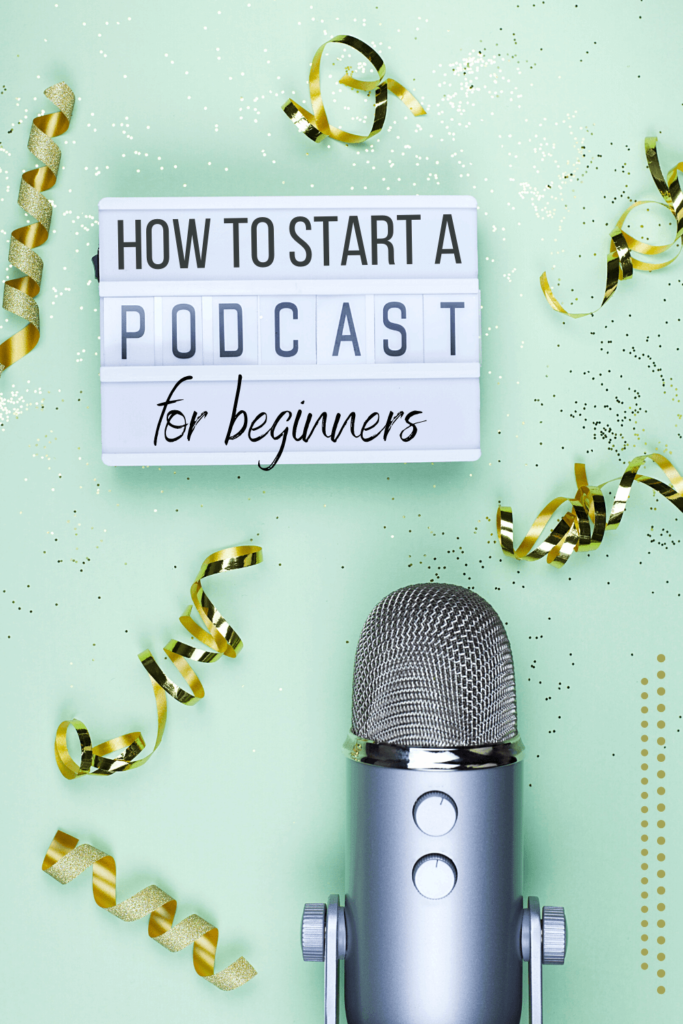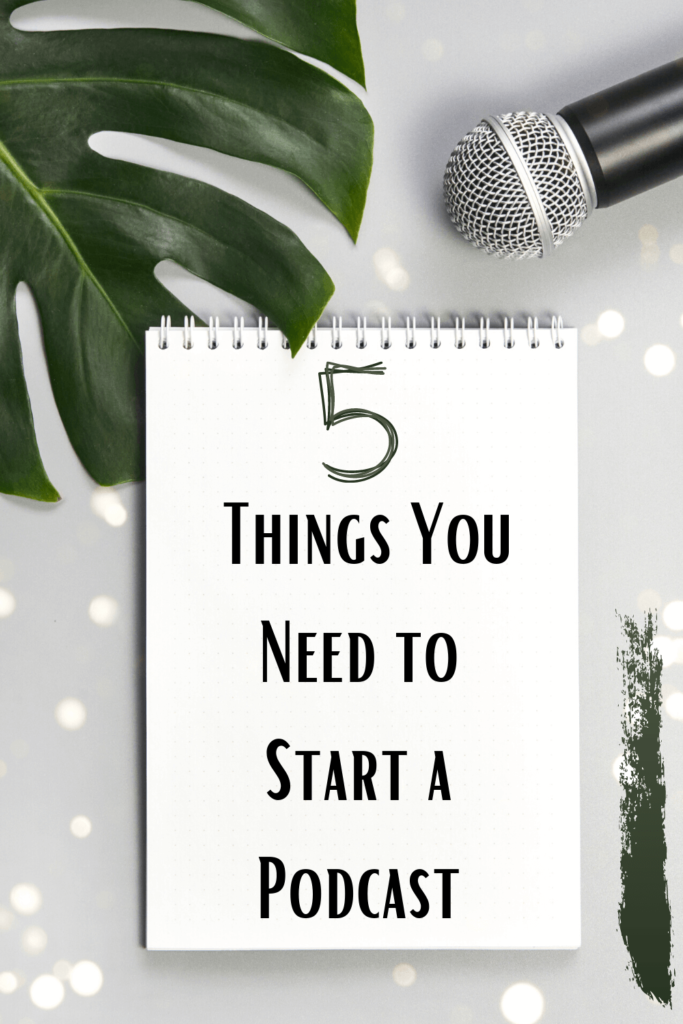How to Start a Solo Podcast: Top 5 Must Haves

Wondering how to start a solo podcast?
I started my own podcast a few years ago because I had a message I wanted to get out to a specific community. Your voice can be a powerful tool, so if you’re wondering how to start a solo podcast read on for my top tips and recommendations to help get you on your way!
How to Start a Solo Podcast: Top 5 Things You Need

As a 1-person team I figured everything out on my own: sourcing and coordinating guests + sponsors, recording, editing, created my own intro and trailer, setting up my own website and hosting site, creating and managing my own social channels…whew! It’s a lot but it’s worth it. Here’s what you need to get going:
1. The Concept: Topic, Format, Name
What is your podcast all about? Who is your target audience? What format will you follow — solo, cohost, guest interviews? Will it be informative, inspirational, entertaining, storytelling?
And, of course, what will you name your podcast? This last bit can trip a lot of people up, and I even changed my podcast name to what it is currently — The Self Worth Edit — right before launch from something else. I had a whole list of potential names.
Spend time with your potential podcast names. Say them aloud, which one flows? Search for them online and on social platforms — would a website and social media handles be available for you?
Is it too similar to any other names out there? Shop them around, are people in your target audience drawn to certain names over others? Is it clear to them. from the name, what the podcast will be about?
2. Podcast Equipment for Beginners
If you’re serious about podcasting, you’ll want a bit of equipment:
Best Mic for Podcasting
Regardless of how frugal you’re feeling when testing out a new project or business idea, there are some areas where you can’t afford to skimp. You certainly don’t need the most expensive mic out there, but you do need something more than the microphone that’s built into your phone or laptop.
Please. Your listeners’ ears will thank you.
Podcasting is all about sound — your voice, into other people’s ears. It doesn’t matter how great your content is if your sound quality is rough, especially when you’re just starting out. First impressions matter.
I did a LOT of research when choosing a mic and my first choice (can’t even remember what it was now) was out of stock which I’d say worked out in my favor because I went with this Samson Q2U instead and I love it.
It’s not too big or aggressive and it’s definitely a step up from no mic at all. I have received such kind compliments from listeners about how soothing my voice is and I can’t help but think I owe at least some credit to my mic! Fellow podcasters have asked me what mic I use as well, so here it is.
This one has my personal stamp of approval and is the one I use for every episode. If you’re looking for a USB microphone for podcasting, this is it. It’s also a dynamic mic, which means it won’t pick up as much background room noise and this makes it an easier mic for beginners to work with.
Plus, it’s compact. I was able to easily pack it in my carryon for my months living in Costa Rica.
Best Headphones for Podcasting
Aside from your mic, the only other piece of actual equipment (assuming you already have a laptop) you need is a pair of headphones.
Closed, over-the-ear headphones like these are best for podcasting because they don’t allow noise leakage the way smaller earbuds do. It’s important, if you’re interviewing someone, to have your headphones so your mic doesn’t capture the other person’s voice.
If you’re recording solo episodes, or when you’re editing, a good pair of headphones helps you better monitor sound quality and adjust your mic technique as needed. I bought these for less than $30 and they’ve been serving me well.
3. Podcasting Software & Apps
Aside from physical equipment, you also need your laptop to be equipped with a few tools. If you’ll be interviewing guests virtually you’ll need either Zoom, Zencastr or SquadCast.
I use Zoom because it’s free (and I also have a paid membership) and it’s important for me to be able to connect visually with my guests. I know podcasters who use and prefer Zencastr. Squadcast is one I’ve heard good things about but don’t feel the need to pay for at the moment.
You’ll also need editing software. I use GarageBand which came built in on my Mac. Podcasters with a PC tend to use Audacity, which you can download for free.

Finally, you’ll need a podcast hosting site. If you’ve ever owned a blog, the concept is similar. For example, I own this website and run it through Bluehost.
There are several podcast hosting sites out there. The best option for me and the one I would recommend to anyone else is Buzzsprout. They offer a 90-day free trial which gave me the opportunity to get started and get a feel for the platform before committing to buy their paid monthly plan.
Had I wanted to, I could have transferred my episodes over to Anchor before my free trial was up but I chose to stay with Buzzsprout. The customer support is great, they offer so many learning resources, the platform is so intuitive and easy to navigate, and it’s been a worthwhile investment all around.
I highly recommend signing up with Buzzsprout.
4. A Website
Wait, I need a podcast hosting site and a website? Look, I always recommend owning your internet real estate when possible. Having your own website to build traffic to and have more control over gives you room for growth and greater personalization.
You could add shop pages over time, blog posts that are separate from your podcast episodes (like this one!) more information about yourself. Plus, it’s nice to be able to say ‘visit selfworthedit.com for more.’ People know where to find me and I can message it quickly.
It’s also an easier way for new podcast listeners to start tuning in if they’re not familiar with where else to go for podcasts. I built this website using WordPress and Bluehost.
If you’ve never built your own website there are elements that can feel tricky, but I’m self taught and there’s nothing I haven’t been able to figure out through a solid Google search.
The basic pages you should set up for your podcast website include: About Me, Listen (where you can embed a podcast player using code from your hosting site) and Contact. Over time, you might also add Shop, Resources and Work With Me pages.
Every episode you publish can be its own blog post when you embed the single episode, add a title, your show notes and a transcript if you have one. All of this is good for SEO, which means it helps your show get found on the internet.
Having individual posts this way also allows you to create Pinterest graphics and use that platform to grow traffic. Pinterest is a huge search engine and Pinterest marketing is a whole other topic.
All you need to worry about early on is getting your basic pages set up, as mentioned above.
5. Accountability & A Plan for Consistency
Podfade is a real thing. Many podcasts don’t make it past 7-10 episodes. I knew that wasn’t an option for me. If I’m going to put all this time and effort in, and if I care about my mission (which I do!) I needed to set myself up for success and longevity.
So, I made a content plan. I mapped out a bunch of different content ideas. Made a list of all the potential guests I’d like to have on. I planned out topics for solo episodes and started drafting them to make sure I knew what I was talking about and had enough useful advice to offer for each.
I created a calendar and started planning out which episode topics would air on which dates.

I determined my cadence — every other week to start with the idea of maybe moving to weekly if things were running smoothly enough once I got started.
My goal for myself? Keep up the consistency for 1 year, at minimum. Thanks to this planning, I was able to launch and be a step ahead of my schedule. I had interviews recorded and ready to take me through the several months at a time.
For accountability and community, I also recommend joining some podcaster groups on Facebook.
*Bonus!* 6. Courage
If you haven’t yet listened to my episode on What it’s Really Like to Feel the Fear and Do It Anyway, go listen. It was directly inspired by how I felt when starting my podcast. I was terrified!
So much imposter syndrome, it would often stop me in my tracks. I was regularly texting and calling my sister to help me out of my fear. I’d have great, productive days working on the podcast only to have a whirlwind of fearful thoughts take over my mind as soon as my head hit my pillow every night.
It takes guts to put yourself out there, to learn and try something brand new. A lot of people don’t make it through the fear. There are podcasting Facebook groups filled with people talking about this fear. Talking, but failing to push through. Talking about how they’ve been sitting on their idea for a year or more because fear is holding them back.
You can have all the tools and know-how you need but if you’re not ready to face, acknowledge and push past your fears you won’t get very far.
And guess what, the fear does subside! Not completely. But it became WAY quieter and less frequent than when I was in the idea, prep and pre-launch phase.
Final Thoughts: How to Start a Solo Podcast
So, there you have it! The top 5 things you need to start and run a podcast as a team of one. I’m sure you’ll have a lot of questions along the way but in the end, the best way to get started is to simply…get started. You’ll learn the most as you go, along the way. Cheers!

